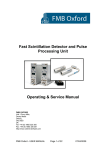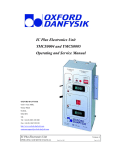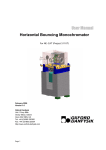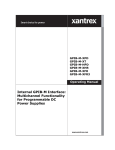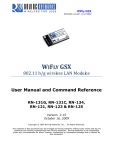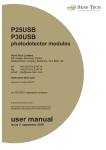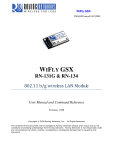Download 6. Pulse Processing Unit
Transcript
CyberstarX1000 Fast Scintillation Detector and Pulse Processing Unit Operating & Service Manual OXFORD DANFYSIK Unit 1 Ferry Mills, Osney Mead Oxford, OX2 0ES UK Tel: +44 (0) 1865 320 300 Fax: +44 (0) 1865 320 301 http://www.oxford-danfysik.com [email protected] Fast Scintillation Detector and Pulse Processing Unit USER MANUAL Date: 22th April 2002 V.3 Page 1 of 20 1. Table of Contents 1. TABLE OF CONTENTS ............................................................................................................................... 2 2. WARRANTY .................................................................................................................................................... 4 3. OXFORD DANFYSIK SOFTWARE LICENCE AGREEMENT AND LIMITED WARRANTY... 5 3.1 3.2 4. LICENCE A GREEMENT ................................................................................................................................ 5 LIMITED WARRANTY.................................................................................................................................. 5 FAST SCINTILLATION DETECTOR...................................................................................................... 6 4.1 SCINTILLATOR ............................................................................................................................................. 6 4.2 4.3 PHOTOMULTIPLIER ...................................................................................................................................... 6 HOUSING...................................................................................................................................................... 7 4.4 CONNECTORS .............................................................................................................................................. 7 4.5 VOLTAGE DIVIDER...................................................................................................................................... 7 4.6 4.7 PREAMPLIFIER............................................................................................................................................. 7 POWER R EQUIREMENT ............................................................................................................................... 7 4.8 CABLES ........................................................................................................................................................ 7 5. 5.1 6. SCINTILLATOR............................................................................................................................................. 8 PROCEDURE FOR CHANGING A SCINTILLATOR .......................................................................................... 8 PULSE PROCESSING UNIT ....................................................................................................................... 9 6.1 DIMENSIONS ................................................................................................................................................ 9 6.2 SHAPING A MPLIFIER ................................................................................................................................... 9 6.3 6.4 SINGLE CHANNEL A NALYSER ................................................................................................................... 10 HIGH VOLTAGE SUPPLY............................................................................................................................ 11 6.5 PHOTOTUBE PREAMPLIFIER POWER ........................................................................................................ 11 6.6 CURRENT CONSUMPTION OF NIM VERSION.......................................................................................... 11 6.7 6.8 M ISCELLANEOUS....................................................................................................................................... 11 OPTIONS .................................................................................................................................................... 11 7. FRONT PANEL DESCRIPT ION............................................................................................................... 12 7.1 HIGH VOLTAGE ......................................................................................................................................... 12 7.2 7.3 PREAMPLIFIER AND SHAPING AMPLIFIER................................................................................................ 12 SINGLE CHANNEL A NALYSER (SCA)....................................................................................................... 13 8. COMMUNICATION BOARD .................................................................................................................. 15 8.1 GENERAL CONSTRUCTION ....................................................................................................................... 15 8.2 HARDWARE WIRING................................................................................................................................. 15 9. REMOTE CONTROL SOFTWARE FOR PULSE PROCES SING ELECTRONIC ...................... 16 9.1 INTRODUCTION.......................................................................................................................................... 16 9.2 DESCRIPTION ............................................................................................................................................. 16 Fast Scintillation Detector and Pulse Processing Unit USER MANUAL Date: 12 Nov 2002 V.4 Page 2 of 20 9.3 COMMANDS LIST...................................................................................................................................... 18 9.4 SYNTAX RULES .......................................................................................................................................... 19 9.5 CONNECTING WITH A HOST COMPUTER................................................................................................ 19 9.6 NETWORK C ONFIGURATION .................................................................................................................... 20 Fast Scintillation Detector and Pulse Processing Unit USER MANUAL Date: 12 Nov 2002 V.4 Page 3 of 20 2. Warranty 1. OXFORD DANFYSIK warrants that the Equipment shall be free from defects by reason of faulty design, workmanship or materials and that if within the guarantee period set out in sub-clause 3 the Equipment proves defective for such reason OXFORD DANFYSIK shall adjust, repair or replace it as it sees fit free of charge, provided that: 1.1 The Equipment has been used solely for the purpose for which OXFORD DANFYSIK understands it is to be used and in accordance with the operating instructions; 1.2 The defect has not been caused by fire, accident, misuse, neglect, incorrect installation by the customer, its customers, agents or servants or unauthorised repair or maintenance or by use of sub-standard consumables; 1.3 The defect has not arisen from any design, specification, component or material supplied by the customer; 1.4 No part of the Equipment has been replaced with a part not supplied by OXFORD DANFYSIK or approved as suitable by it; 1.5 Payment in full of all sums due in respect of the Equipment has been made; 1.6 The customer shall be liable for any costs incurred by OXFORD DANFYSIK in responding to claims made in respect of erroneous results caused by operator error or incorrect application; 1.7 Upon the customer making a claim under sub-clause 1 it shall accord sufficient access to the Equipment to enable OXFORD DANFYSIK staff to inspect and adjust, repair, remove or replace the Equipment; 1.8 OXFORD DANFYSIK will co-operate with the customer in the assessment of reported defects but the final decision regarding the applicability of this guarantee shall rest with OXFORD DANFYSIK. 2. OXFORD DANFYSIK shall decide if the Equipment should be repaired pursuant to sub-clause 1 at its site or returned. 3. The applicable guarantee period shall be 12 months after delivery save where the Equipment is installed and/or commissioned by or under the supervision of OXFORD DANFYSIK in which case it shall be 12 months from the date of the installation certificate or 18 months after the date of delivery, whichever is the earlier. Fast Scintillation Detector and Pulse Processing Unit USER MANUAL Date: 12 Nov 2002 V.4 Page 4 of 20 3. Oxford Danfysik Software Licence Agreement and Limited Warranty 3.1 Licence Agreement As part of the sales package for the OXFORD DANFYSIK pulse processing units, the customer will receive from OXFORD DANFYSIK a licence to use the accompanying software subject to the following terms and conditions; • The software package may be used, without time limit, on one personal computer or workstation. • A separate licence agreement and fee is required for each additional personal computer or workstation on which the package is used. • The software package may not be duplicated or copied except for archive purposes or to replace defective media, and each copy made must bear the copyright notices carried on the original. The software package may not be transferred in any event to a third party unless written consent is obtained from OXFORD DANFYSIK. • This software package is protected under copyright law and OXFORD DANFYSIK reserves the right to terminate this licence upon any violation of these laws. In the event of termination, the customer will be required to return all copies of the software package to OXFORD DANFYSIK. • Some parts of the software package are specially protected in order to be read or modified only by OXFORD DANFYSIK engineers. Under no circumstances will OXFORD DANFYSIK be under obligation to disclose information relating to these parts of the software. 3.2 Limited Warranty The standard software is fully tested and under normal use is guaranteed to be free of bugs and defects on pulse processing units. This insurance is not valid for special software adaptations on non-standard pulse processing units. In this case, OXFORD DANFYSIK agrees to correct at its own expense, during a one year warranty period, any defect arising during the use of the modified software package. In no event will OXFORD DANFYSIK be liable for any direct or indirect incidental or consequential damages arising from a software failure. Fast Scintillation Detector and Pulse Processing Unit USER MANUAL Date: 12 Nov 2002 V.4 Page 5 of 20 4. Fast Scintillation Detector Caution : LETHAL VOLTAGE PRESENT INSIDE DEVICE WHEN OPERATED: 1250 VOLTS MAXIMUM High Voltage supply . USER MUST DISCONNECT DEVICE BEFORE OPENING HOUSING FOR ANY REASON. Please note that permanent damage to the phototube can occur if rated High Voltage supply value (above) is exceeded. Disturbing ground loops warning : In order to avoid unwanted effects, the body of the phototube should always be electrically isolated from the experiment where it is installed. Shielding ground warning : In order to obtain the best signal shielding, the body of the phototube must always be electrically connected to the ground of the pulse processing electronics used . 4.1 Scintillator • type Thallium activated NaI. Easily interchangable thickness on customer request (minimum 1 mm). Other scintillators available (BGO, BaF 2, CsI, CsI(TI), CsF, YAP) • detector aperture standard Φ 32 mm • energy up to 50 KeV - NaI(TI), 10 MeV - BGO • window Beryllium, 0.2 mm thickness, optional aluminium • background below 0.2 cps at 5 KeV - NaI(TI) 4.2 Photomultiplier • diameter 38 mm (scintillator Φ 32 mm) • photocathode bialkali, adapted to the NaI(TI) scintillation wavelength • structure 10 dynodes • gain 106 typical • anode signal rise time 2.8 ns. Fast Scintillation Detector and Pulse Processing Unit USER MANUAL Date: 12 Nov 2002 V.4 Page 6 of 20 4.3 Housing • precisely machined from aluminium alloy. Can be opened for easy access to every component • external dimensions • O rings for light tightness • µ metal shielding Φ 48 mm, L 138 mm 106 typical 4.4 Connectors • high voltage Lemo ERA size zero • signal and low voltage Amphénol 17DMW • other connectors on customer request 4.5 Voltage Divider • principle passive dynode chain • impedance 1.8 MΩ 4.6 Preamplifier • for low noise and improved speed, this is directly attached to the dynode chain • output impedance 50 Ω • gain bandwidth product 180 MHz • slew rate 2000 V/µs • driving capability short circuit protected 4.7 Power Requirement • high voltage supply + 1250 V maximum • high voltage current 0.7 mA • preamplifier supply NIM standard ± 12 V • current required 15 mA on the + 12 V 15 mA on the - 12 V 4.8 Cables • High voltage, signal, preamplifier standard 5 metre length supply • Option non -standard cable length Fast Scintillation Detector and Pulse Processing Unit USER MANUAL Date: 12 Nov 2002 V.4 Page 7 of 20 5. Scintillator A large range of scintillators is available from OXFORD DANFYSIK. 5.1 Procedure for Changing a Scintillator • Disconnect the detector from its cab les. • Remove the two M 2.5 screws. Labelled “back screws” on the detector drawing. • The connector plate is pushed externally by a spring situated inside the detector. Disengage the connector back plate from the detector body. Do not twist and break the con nector cables, these are Teflon and welding points are fragile. • Holding the scintillator housing steady in one hand, unscrew the detector body. During this operation the disengaged connector back plate must not rotate. • When unscrewed, slide the scintillator along the front face of the phototube to a position where it touches the scintillator housing internal thread. • The phototube is coupled to the scintillator window by optical grease. This coupling must be broken, for this operation, grasp the detector body in one hand and the scintillator housing in the other and apply a constant gentle force, after some seconds the optical coupling will disconnect. • Clean the phototube and the scintillator windows with alcohol. Store the scintillator in a safe, dry and dark place. • Thread the new scintillator on to the detector body. • On the centre of the phototube window apply ¼ cm3 of optical grease, do not spread this. We recommend the thixotropic product from Dow Corning, Q2-3067. Never use a non-thixotropic grease. • Re-insert the phototube assembly inside the detector body and tighten the M 2.5 back screws on the connector plate, being careful not to wear the threads. The internal spring will gently squeeze the silicon optical couplant. • After five - ten hours the detecto r will be ready to use. Fast Scintillation Detector and Pulse Processing Unit USER MANUAL Date: 12 Nov 2002 V.4 Page 8 of 20 6. Pulse Processing Unit Caution : LETHAL VOLTAGE PRESENT INSIDE DEVICE WHEN OPERATED: 1250 VOLTS MAXIMUM High Voltage supply . USER MUST DISCONNECT DEVICE BEFORE OPENING HOUSING FOR ANY REASON. Please note that permanent damage to the phototube can occur if rated High Voltage supply value (above) is exceeded. Disturbing ground loops warning : In order to avoid unwanted effects, the body of the phototube should always be electrically isolated from the experiment where it is installed. Shielding ground warning : In order to obtain the best signal shielding, the body of the phototube must always be electrically connected to the ground of the pulse processing electronics used . 6.1 Dimensions • external double NIM unit, 6.86 cm x 22.13 cm or 19 inches - 3U Europe-standard rack 6.2 Shaping Amplifier • advantages fast speed dc-coupling • gain front panel adjustable 10 turns potentiometer • shaping constant rotating front panel four position switch, position 1) peaking time 300 ns semi gaussian 2) peaking time 0.5 µs gaussian 3) peaking time 1 µs gaussian 4) peaking time 3 µs gaussian • dead time smooth and predictable counting loss leading to an easy correction dead time correction up to 800 000 cps (peaking time 300 ns). • base line restorer innovative base line restorer, virtually no base line shift at high counting rate, active even on undershoot of high energy saturating pulse. Fast Scintillation Detector and Pulse Processing Unit USER MANUAL Date: 12 Nov 2002 V.4 Page 9 of 20 • BNC pulse output • output level unipolar pulses output available on the front panel. Can be connected to a multi-channel analyser maximum output voltage clamped to 10 volts 1 ns override recovery time 6.3 Single Channel Analyser 1) front panel ten turns potentiometer − lower level adjustable between 50 mV and 10 V • precision of the reading ± 10 mV • linearity error ± 10 mV • thermal drift 0.1 mV/0C over the range of 10 to 500C − upper level adjustable between 50 mV and 10 V • precision of the reading ± 10 mV • linearity error ± 10 mV • thermal drift 0.1 mV/0C over the range of 10 to 500C 2) operating mode − front panel four position switch • normal upper and lower level are separately adjustable between 0 and 10 V • integral upper level disabled • asymmetric upper level button adjusts the window between 0 and 1 • symmetrical V above the lower level upper level button symmetrically adjusts the window + 0.5 V above and - 0.5 V below the lower level 3) BNC output signal • protection every output is short circuit protected • standard signal TTL output positive going 10 ns rise time zero: 800 mV; logical 1:2 volts minimum into a 50 Ω load • duration internal jumper selected 100 ns or 500 ns • front panel upper level, lower level and window output • miscellaneous no output on upper level or window if the upper level is below the lower level • current NIM pulses available on any BNC output through a jumper selection logical 1 between - 36 mA and - 12 mA Fast Scintillation Detector and Pulse Processing Unit USER MANUAL Date: 12 Nov 2002 V.4 Page 10 of 20 6.4 High Voltage Supply • Display 3 ½ digit bright LCD, 14 mm high numbers • output voltage adjustable by a front panel 10 turns potentiometer • output current 1.2 mA • ripple 5 mV • thermal drift 50 ppm of the full scale per degree celcius • protection short circuit protected • output on the rear panel one SHV high voltage socket • current consumption 250 mA maximum on the + 24 V line between 250 V and 1250 V 6.5 Phototube Preamplifier Power rear panel NIM standard 9 pins sub D female connector 6.6 Current Consumption of NIM version • 300 mA maximum on the + 24 V line • 120 mA on the - 24 V line • 330 mA on the + 12 V line • 90 mA on the - 12 V line 6.7 Miscellaneous saturation ouput signal (for actuating a beam shutter) generated by RS232 communication board: • PNP open collector, pull down resistor • 10 mA available when ON • Available on a rear panel BNC connector 6.8 Options - detector to pulse processing unit connection cable, total lengths of 5,10, 15 and 20 m available. - RS232 communication cable, total lengths of 5, 10, 15 and 20 m available. Fast Scintillation Detector and Pulse Processing Unit USER MANUAL Date: 12 Nov 2002 V.4 Page 11 of 20 7. Front Panel Description 7.1 High Voltage • Four digit display indicates the value of the set voltage. • Voltage can vary between 250 and 1250 V (other ranges on request) • When high voltage is increased, gain of the phototube increases but natural noise increases also • When a low noise is required at low energy, the best trade off must be found between gain of the preamplifier and magnitude of the high voltage • Normal condition for the photomultiplier is between 800 and 1000 V 7.2 Preamplifier and Shaping Amplifier The preamplifier gain ten turns potentiometer adjusts the amplitude of the shaped pulses available on the signal out of the BNC socket. These pulses are clipped at 10 V (adjustable by the trim potentiometer R106, see RX board drawing). This signal can be directly sent to a multichannel analyser, it is a positive signal without negative undershoot. The four position rotating switch adjusts the shaping constant. Instead of this not “directly measurable parameter” the peaking time is indicated. This is the time elapsed between the arrival of an X or γ photon inside the scintillator and the peak value of the signal out pulse. A small value of the peaking time allows high counting rate but poor energy linearity. A high value of the peaking time allows good energy linearity but the counting rate is limited by pile up of shaped pulses. Peaking time of 0.5, 1 and 3 µs are obtained by three different order filters. Coefficient of these filters were selected for minimum delay and ringing. Fast Scintillation Detector and Pulse Processing Unit USER MANUAL Date: 12 Nov 2002 V.4 Page 12 of 20 7.3 Single Channel Analyser (SCA) Upper level and lower level adjustment is available on the front panel. Four modes of selection are provided: n as normal int as integral a as asymmetric s as symmetrical These modes are absolutely identical to modes available on SCA’s from other manufacturers. NORMAL MODE Range of Variation Lower level 0.02 to 10 V Front Panel BNC Logic Output out when leading edge of the shaped pulse crosses lower level voltage Upper level 0 to 10 V out when leading edge of the shaped pulse crosses upper level voltage Window / out when falling edge of the shaped pulse crosses lower level only INTEGRAL MODE Range of Variation Lower level 0.02 to 10 V Front Panel BNC Logic Output out when leading edge of the shaped pulse crosses lower level voltage Upper level Window disabled no output not applicable ASYMMETRIC MODE Identical to the previous normal mode but in this case the upper level 10 turns potentiometer defines a window adjustable between 0 and 1 V. The bottom value of this window is bounded to the lower level. Changing the low level from 0 to 10 V allows the window to scan the entire shaped pulse amplitude. On the other han d front panel BNC logic output are described exactly as in the normal mode. Fast Scintillation Detector and Pulse Processing Unit USER MANUAL Date: 12 Nov 2002 V.4 Page 13 of 20 SYMMETRICAL MODE This is as for the asymmetric mode, but here adjusting the upper level potentiometer increases the window symmetrically up to + 0.5 V above and 0.5 V below the low level value. FRONT PANEL BNC LOGIC OUTPUT The TTL or negative current fast NIM logic is jumper selected. The logical one duration can be 100 ns or 500 ns selected. For location of these jumpers refer to the RX board drawing. Duration or logic can be independently set on each output. Fast Scintillation Detector and Pulse Processing Unit USER MANUAL Date: 12 Nov 2002 V.4 Page 14 of 20 8. Communication Board Enables RS232 communication, allowing cascading of up to 16 units. For each unit, the following parameters can be independently controlled: - Phototube high voltage - Preamplifier gain - Single channel analyser lower and upper levels - Shaping constant - Saturation time duration allowed The software and instructions to remote control the X1000 unit are described in the next paragraph. To setup a communication with a PC (Windows™ operated), a DEMO software and a CONTROL software are supplied in the attached floppy discs. 8.1 General Construction The communication board is made around a C programmable miniature controller “Little Star” from Z World Engineering. If user needs to make a special operating algorithm this can be programmed with the integrated C development environment which can be delivered through OXFORD DANFYSIK. 8.2 Hardware Wiring Four digital to analog converters and a set of gates are connected to the miniature controller to drive the various parameters of the pulse processing unit. Fast Scintillation Detector and Pulse Processing Unit USER MANUAL Date: 12 Nov 2002 V.4 Page 15 of 20 9. Remote Control Software for Pulse Processing Electronic 9.1 Introduction The pulse processing units can be remotely controlled by a host computer (PC or workstation) through a serial link (RS232). A network of up to 16 units can be built, requiring only one serial port on the host computer. The communication protocol is a subset of the SCPI (Standard Commands for Programmable Instruments) language. A communication software example is given in the DEMO software, showing various possible command lines. This can help users to develop their own remote control interface software. The purpose of the CONTROL software is to enable users to immediately setup a complete run-time interface link between a Personnal Computer (Windows operated) and one or more X1000 units. Both softwares can be installed on the same computer (just run Setup.exe from the floppy disc). Warning: Before using these softwares, you should make copies of your original floppy discs. You should never use the original floppy discs for everyday operations. Store them in a safe place. 9.2 Description The pulse processing unit holds a C programmable miniature controller. The program is factory stored in its EPROM. According to the selected control mode, this program is able to drive the unit, by controlling the gain, the peaking time and the single channel analyser upper and lower levels. The high voltage power supply can be controlled when it is installed as an option in the unit. Saturation threshold detection is also provided. Three communication modes are possible; local (manual control), remote and forced remote (host control). In local mode the unit is front panel operated. In remote and forced remote mode, the unit is driven by commands coming from a host computer. Front panel switches and potentiometers are disabled and the red LED is lit by the miniature controller. Local and remote modes are obtained by positions of the local/remote button on the front panel. Fast Scintillation Detector and Pulse Processing Unit USER MANUAL Date: 12 Nov 2002 V.4 Page 16 of 20 The forced remote mode is selected by the host computer and has priority over other control modes. It can be cancelled only from the host computer or by switching the unit off and on. When turning on the power the unit is reset and the built -in beeper is sounded, as it is also at every reset command sent by the host computer. As a safety feature, the delay for taking into account the beam saturation is set to 2 s. The beam saturation signal is monitored at a rate of 100 ms. When the saturation duration exceeds the preset delay, a digital signal goes high (this signal can be used for actuating a beam shutter), the high voltage is set down to 250 V, the forced remote mode is selected and the security status is enabled. This status can be disabled only by either switching the unit off and on or by sending a command from the host. In local mode, the program stored in the miniature controller continuously polls the status of the local/remote button and checks if a forced remote command or query was received. Other commands are acknowledged. The first time the remote mode (switching the local/remote button) or forced remote mode (receiving a command from the host) is entered, high voltage is reduced to 250 V (the power supply option is installed), peaking time to 300 ns, single channel analyser upper channel to 10 V, single channel analyser lower channel to 0.5 V and gain to 0%. In these modes, commands coming from the host computer are processed. Do not forget to increase the gain in order to get a signal. Every unit has an address given by DIP swit ches 1 through 4 (SW1 on the communication board) where switch 1 corresponds to address bit 0, and switch 4 corresponds to bit 3. A switch setting of OFF determines a bit value of 1 and a setting of ON determines a value of 0. Factory address setting is 0. Always switch the unit off before changing its address. A unit address 7 corresponds to switches 1 OFF, 2 OFF, 3 OFF, 4 ON. Fast Scintillation Detector and Pulse Processing Unit USER MANUAL Date: 12 Nov 2002 V.4 Page 17 of 20 9.3 Commands List Syntax Meaning *RSTad reset the unit :SYSTad:COMM:REM ON switch forced remote control on :SYSTad:COMM:REM OFF switch forced remote control off :INPad:GAIN x set gain to x value :SENSad:SCA:UPP x set single channel analyser (SCA) upper level to x value :SENSad:SCA:LOW x set single channel analyser (SCA) lower level to x value :SENSad:PKT x set peaking time to x value :SOURad:VOLT x set high voltage to x value (if the power supply option is installed) :SYSTad:SEC ON enable security status :SYSTad:SEC OFF disable security status :TRIGad:ECO x set the delay for taking into account the beam saturation ad (unit address): an integer value from 0 to 15. It may be left out of the command when unit is set to address 0. For example, *RST and *RST0 are both valid commands. Values range for x parameter high voltage from 250 V to 1250 V gain from 0% to 100% peaking time 300 ns, 500 ns, 1000 ns or 3000 ns SCA upper level from SCA lower level to 10 V SCA lower level from 0 V to SCA upper level delay from 20 (2 s) to 3000 (300 s) (after this delay the security status is enabled and the saturation output signal goes high) Examples :INPO:GAIN 12.5 :SENS0:SCA:LOW 1.5 These commands set the gain at 12.5% and the SCA lower level at 1.5 V (the address of the unit being 0) :INP15:GAIN 12.5 :SENS15:SCA:LOW 1 Same command with a different address (15) Fast Scintillation Detector and Pulse Processing Unit USER MANUAL Date: 12 Nov 2002 V.4 Page 18 of 20 All commands but *RSTad consist of two distinct parts; a header and a value. They have an additional query form, in which a question mark replaces the value (do not insert a space character between header and question mark). When a query form is received, the program sends the current value associated with the command. Query responses do not include the command header. Examples :INP0:GAIN? query from the host computer 12.5 value sent to the host computer :SYST0:COMM:REM? query 1 means ON (Forced remote mode on ) :SYST0:SEC? query 0 means OFF (security status is disabled) Warning: The program waits for strings ending with a special character (ASCII code = 10). This character must be transmitted by the host computer. When the program sends a current value, it also sends this character after the value. Every time this special character is acknowledged, the program sends a single character (ASCII code = 6) to the host. 9.4 Syntax rules Upper and lower case characters are accepted. At least one space character is mandatory befor e a decimal data or before ON and OFF. 9.5 Connecting with a Host Computer This unit can be connected to a RS232 port of a host computer. Only three wires are needed. The RS232 connector is located on the rear panel of the unit. Ground signal is pin 5, receive signal pin 2 and transmit signal pin 3. The receive signal of the OXFORD DANFYSIK unit must be connected to the receive signal of the host computer. If the host computer is a PC, pins 4, 6 and 8 must be tied together on the cable connector (PC side). Fast Scintillation Detector and Pulse Processing Unit USER MANUAL Date: 12 Nov 2002 V.4 Page 19 of 20 The following protocol is supported by the OXFORD DANFYSIK unit: - baud rate 9600 - data format 8 bits ASCII data and 1 stop bit - parity none CTS, RTS signals are disabled. 9.6 Network Configuration These units are designed to operate in a network. Up to 16 units can be linked together using only one RS232 port of the host computer. When a unit is linked to the network, its address must not be already in use by any of the other units. The wiring for a network (including two units) connected to a PC , is detailed hereafter. PC Unit A Unit B connector connector connector 2 (RX) }- - - -{ 3 (TXO) 3 (TX) }cable 1 { 2 (RXO) 5 (ground) }- - - -{ 5 (ground) }- - - { 5 (ground) 7 (RX1) }cable 2{ 3 (TX0) 8 (TX1) }- - - { 2 (RX0) When the unit B is disconnected, pins 2 and 3 of the connector located at the end of cable 2 must be grounded with a 1000 Ω resistor. When a unit is in local mode, it does not stop communication with other units in remote or forced remote mode. For example, if unit A is in local mode and unit B is in remote mode, the PC can send commands to unit B and receive data from unit B. Fast Scintillation Detector and Pulse Processing Unit USER MANUAL Date: 12 Nov 2002 V.4 Page 20 of 20




















